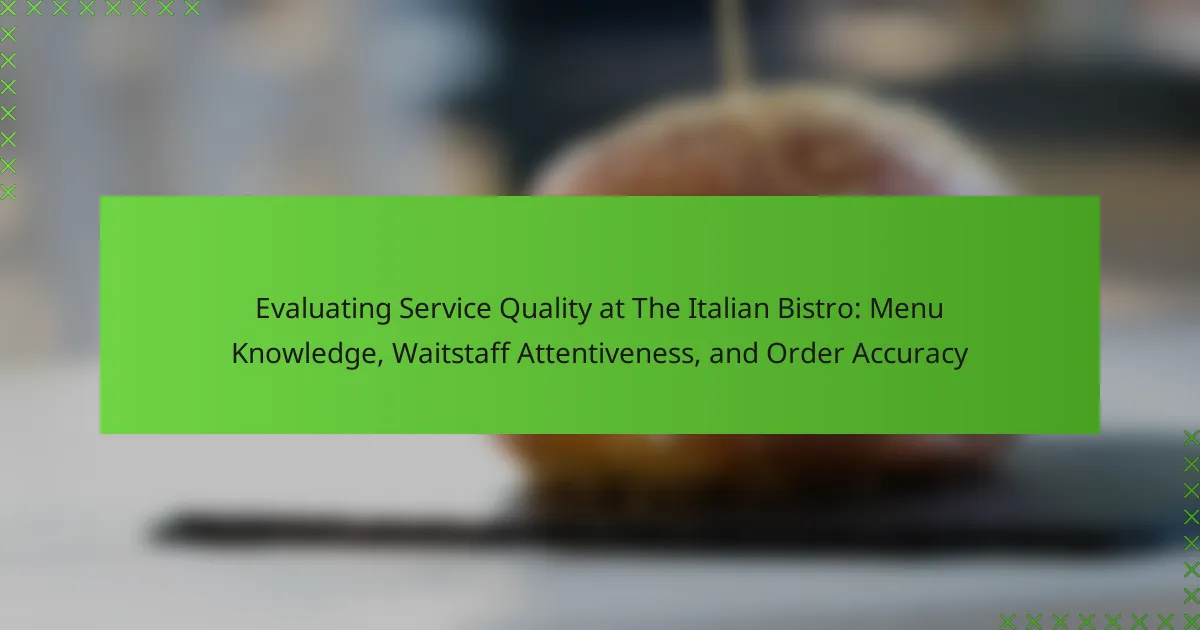
What is Service Quality at The Italian Bistro?
Service quality at The Italian Bistro is characterized by high standards in menu knowledge, waitstaff attentiveness, and order accuracy. The staff is trained to possess extensive knowledge of the menu items, including ingredients and preparation methods. This ensures that customers receive informed recommendations and answers to their questions. Waitstaff attentiveness is emphasized, with staff members trained to monitor customer needs and provide timely service. Order accuracy is a critical aspect, with a focus on delivering the correct dishes as requested by customers. These factors contribute to an overall positive dining experience, as evidenced by customer satisfaction ratings and reviews.
How is service quality defined in the context of restaurants?
Service quality in the context of restaurants is defined as the overall assessment of the dining experience provided to customers. It encompasses factors such as menu knowledge, waitstaff attentiveness, and order accuracy. High service quality leads to customer satisfaction and loyalty. Research indicates that effective communication and responsiveness from staff significantly enhance perceived service quality. According to a study published in the Journal of Hospitality Management, attentive service can increase customer retention by up to 30%.
What are the key components of service quality?
The key components of service quality are reliability, responsiveness, assurance, empathy, and tangibles. Reliability refers to the ability to deliver promised services dependably and accurately. Responsiveness is the willingness to help customers and provide prompt service. Assurance involves the knowledge and courtesy of employees, instilling confidence in customers. Empathy is the provision of caring, individualized attention to customers. Tangibles are the physical facilities, equipment, and appearance of personnel that contribute to the overall service experience. These components are essential for evaluating service quality in any dining establishment, including The Italian Bistro.
Why is service quality important for customer satisfaction?
Service quality is crucial for customer satisfaction because it directly influences a customer’s perception of value. High service quality leads to positive experiences, fostering customer loyalty. According to a study by Zeithaml, Berry, and Parasuraman, service quality is a key determinant of customer satisfaction across various industries. When customers receive attentive service, accurate orders, and knowledgeable staff, they are more likely to feel valued. This feeling enhances their overall dining experience at establishments like The Italian Bistro. Additionally, satisfied customers are more likely to return and recommend the restaurant to others, driving repeat business and positive word-of-mouth.
What factors influence service quality at The Italian Bistro?
Service quality at The Italian Bistro is influenced by menu knowledge, waitstaff attentiveness, and order accuracy. Menu knowledge enables staff to provide informed recommendations and answer customer inquiries effectively. Waitstaff attentiveness ensures that customers feel valued and their needs are promptly addressed. Order accuracy is critical for customer satisfaction, as incorrect orders can lead to dissatisfaction. Together, these factors create a positive dining experience, encouraging repeat visits and customer loyalty.
How does menu knowledge impact customer experience?
Menu knowledge significantly enhances customer experience in dining establishments. When waitstaff possess in-depth menu knowledge, they can provide informed recommendations. This leads to increased customer satisfaction as diners feel guided in their choices. Knowledgeable staff can also answer questions about ingredients and preparation methods. This transparency builds trust and confidence in the dining experience. Research indicates that restaurants with well-informed staff see higher customer retention rates. A study by the Cornell University School of Hotel Administration found that menu knowledge directly correlates with perceived service quality. Consequently, better menu knowledge fosters a positive atmosphere and encourages repeat visits.
In what ways does waitstaff attentiveness affect service quality?
Waitstaff attentiveness significantly enhances service quality by fostering customer satisfaction. Attentive waitstaff promptly address customer needs and inquiries. This responsiveness leads to a more enjoyable dining experience. Research indicates that attentive service correlates with higher customer ratings. A study by the Cornell University School of Hotel Administration found that attentive waitstaff increase repeat patronage by 20%. Additionally, attentive waitstaff can anticipate needs, reducing wait times for refills or additional orders. This proactive approach ensures that customers feel valued and cared for. Overall, attentiveness directly impacts perceived service quality and customer loyalty.
What role does order accuracy play in customer satisfaction?
Order accuracy is crucial for customer satisfaction. Accurate orders lead to positive dining experiences. When customers receive exactly what they requested, it enhances their overall perception of service quality. Studies show that 70% of customers cite order accuracy as a key factor in their satisfaction. Errors in orders often result in dissatisfaction and complaints. High order accuracy can increase repeat business and customer loyalty. In the competitive restaurant industry, maintaining order accuracy is essential for success.

How can we evaluate Menu Knowledge at The Italian Bistro?
Menu knowledge at The Italian Bistro can be evaluated through staff assessments and customer feedback. Conducting regular quizzes for staff can measure their understanding of menu items. Observing interactions between waitstaff and customers provides insights into their knowledge application. Customer surveys can gather perceptions of staff expertise regarding menu offerings. Analyzing order accuracy also reflects menu knowledge, as mistakes may indicate gaps in understanding. Training sessions can be held to improve knowledge and address deficiencies. Tracking staff performance over time helps identify trends in menu knowledge.
What does menu knowledge entail for waitstaff?
Menu knowledge for waitstaff entails a comprehensive understanding of the restaurant’s offerings. This includes knowledge of ingredients, preparation methods, and flavor profiles. Waitstaff must also be familiar with dietary restrictions and allergens present in menu items. Additionally, they should be able to recommend dishes based on guest preferences. Effective menu knowledge enhances the dining experience and increases customer satisfaction. Studies show that knowledgeable waitstaff can significantly influence customer decisions and improve overall service quality.
How does extensive menu knowledge enhance customer interactions?
Extensive menu knowledge enhances customer interactions by allowing staff to provide informed recommendations. This knowledge helps waitstaff answer questions accurately and confidently. Customers appreciate personalized suggestions based on their preferences. Studies show that informed staff can increase customer satisfaction by over 20%. Additionally, menu knowledge reduces order inaccuracies. This leads to a smoother dining experience. Overall, well-informed staff can create a more engaging atmosphere for customers.
What training methods improve waitstaff’s menu knowledge?
Effective training methods to improve waitstaff’s menu knowledge include hands-on practice, role-playing, and regular tastings. Hands-on practice allows waitstaff to engage directly with the menu items. Role-playing scenarios can simulate customer interactions, enhancing recall and confidence. Regular tastings familiarize staff with flavors and presentations. Research indicates that experiential learning significantly boosts retention rates among service staff. A study by the National Restaurant Association found that ongoing training programs can increase menu knowledge retention by up to 50%. These methods create a comprehensive understanding of the menu, leading to improved service quality.
How is menu knowledge assessed in a dining setting?
Menu knowledge is assessed in a dining setting through various methods. Staff members are often tested on their ability to accurately describe menu items. This includes knowledge of ingredients, preparation methods, and flavor profiles. Observations during service can also evaluate how well staff respond to customer inquiries. Regular training sessions enhance staff familiarity with the menu. Customer feedback provides insights into staff performance regarding menu knowledge. Additionally, mystery diners may be employed to assess service quality anonymously. These assessments ensure that staff maintain a high standard of menu knowledge.
What evaluation methods can be used to measure waitstaff’s knowledge?
Written tests can be used to measure waitstaff’s knowledge. These tests assess understanding of the menu, ingredients, and preparation methods. Role-playing scenarios can simulate real-life service situations. This method evaluates how well staff can communicate menu details to customers. Observational assessments involve supervisors monitoring staff interactions with guests. This provides insight into practical application of knowledge. Customer feedback can also serve as an evaluation method. Reviews often highlight waitstaff’s knowledge and its impact on the dining experience. Training sessions can be followed by quizzes to reinforce learning. This method ensures retention of critical information.
How do customer feedback and surveys contribute to this evaluation?
Customer feedback and surveys provide essential insights into service quality at The Italian Bistro. They allow customers to express their satisfaction regarding menu knowledge, waitstaff attentiveness, and order accuracy. This information helps identify strengths and weaknesses in service delivery. For example, high ratings in waitstaff attentiveness indicate effective training and engagement. Conversely, negative feedback can highlight areas needing improvement, such as order accuracy issues. Surveys also quantify customer sentiments, enabling data-driven decisions. Research shows that businesses utilizing customer feedback improve performance by 10-15% (Source: Harvard Business Review, “The Value of Customer Feedback,” authors: Mark Murphy).

What is the significance of Waitstaff Attentiveness at The Italian Bistro?
Waitstaff attentiveness at The Italian Bistro is crucial for enhancing the dining experience. Attentive waitstaff can promptly address customer needs and preferences. This leads to increased customer satisfaction and loyalty. Studies show that attentive service correlates with higher tips and repeat visits. Additionally, effective communication from waitstaff can facilitate better order accuracy. This minimizes errors and enhances meal enjoyment. Overall, waitstaff attentiveness contributes significantly to the overall service quality at The Italian Bistro.
How does waitstaff attentiveness influence the dining experience?
Waitstaff attentiveness significantly enhances the dining experience. Attentive waitstaff can promptly address customer needs. This includes taking orders accurately and refilling drinks without being asked. Studies show that higher levels of attentiveness correlate with increased customer satisfaction. For instance, a survey by the National Restaurant Association found that 70% of diners rated service quality as a key factor in their overall experience. Furthermore, attentive service can lead to repeat business and positive reviews. This indicates that waitstaff attentiveness is crucial for a successful dining atmosphere.
What behaviors exemplify attentive waitstaff?
Attentive waitstaff exhibit several key behaviors. They consistently check on guests to ensure satisfaction. They promptly refill drinks without being asked. They maintain eye contact and are responsive to non-verbal cues. They demonstrate knowledge of the menu and provide recommendations. They anticipate needs, such as offering condiments or utensils. They handle requests efficiently and with a positive demeanor. These behaviors contribute to a positive dining experience. Research indicates that attentive service enhances customer satisfaction and repeat visits.
How can attentiveness be measured during service?
Attentiveness during service can be measured through various methods. One effective way is through direct observation of staff interactions with customers. Observers can note the frequency of check-ins and responsiveness to customer needs. Another method is customer feedback, which can be gathered through surveys or comment cards. These tools can provide insights into perceived attentiveness levels. Additionally, measuring response times to customer requests can quantify attentiveness. Research indicates that a high level of attentiveness correlates with increased customer satisfaction. For instance, a study by Zeithaml et al. (1996) emphasizes the importance of service responsiveness in enhancing overall service quality.
What strategies can enhance waitstaff attentiveness?
Training programs for waitstaff can enhance attentiveness significantly. Regular training sessions improve knowledge of menu items and service standards. This knowledge allows staff to respond effectively to customer inquiries. Implementing a system of feedback ensures waitstaff understand areas needing improvement. Encouraging staff to engage with customers fosters a welcoming atmosphere. High employee morale correlates with improved attentiveness, so recognizing and rewarding staff efforts is essential. Utilizing technology, like tablets for order taking, can streamline service and reduce errors. Research indicates that attentive service increases customer satisfaction and repeat business, validating these strategies.
How do training programs improve attentiveness among staff?
Training programs enhance staff attentiveness by providing structured learning experiences. These programs teach employees about customer service best practices. They also emphasize the importance of active listening and engagement with customers. Improved knowledge leads to greater confidence in interactions. Confident staff are more likely to stay focused during service. Research indicates that trained employees demonstrate higher levels of attentiveness. A study by the National Restaurant Association found that training increases service quality ratings significantly. This correlation highlights the effectiveness of training in fostering attentiveness among staff.
What role does management play in fostering a culture of attentiveness?
Management plays a crucial role in fostering a culture of attentiveness. It sets the tone for service expectations through training and communication. Management develops policies that prioritize customer engagement. Regular feedback mechanisms are implemented to assess attentiveness levels. Recognition programs are established to reward attentive behavior among staff. Training sessions focus on enhancing interpersonal skills and product knowledge. Research indicates that attentive service improves customer satisfaction and retention rates. Therefore, effective management practices directly influence the attentiveness culture within the establishment.

Why is Order Accuracy crucial at The Italian Bistro?
Order accuracy is crucial at The Italian Bistro because it directly impacts customer satisfaction. Accurate orders ensure that guests receive the meals they expect, which enhances their dining experience. When orders are incorrect, it can lead to frustration and disappointment. This can ultimately result in negative reviews and loss of repeat business. Studies show that 70% of customers are likely to return if their order is correct. Furthermore, order accuracy reflects the professionalism of the waitstaff and kitchen staff. High accuracy rates contribute to the overall reputation of The Italian Bistro as a quality dining establishment.
How does order accuracy affect customer satisfaction?
Order accuracy significantly affects customer satisfaction. Accurate orders lead to positive dining experiences. When customers receive what they ordered, they feel valued and respected. A study by the Journal of Hospitality Management found that 70% of customers rated order accuracy as a top factor in their satisfaction. In contrast, incorrect orders often result in frustration and disappointment. This dissatisfaction can lead to negative reviews and loss of repeat business. Therefore, maintaining high order accuracy is crucial for enhancing customer satisfaction in restaurants.
What are the common causes of order inaccuracies in restaurants?
Order inaccuracies in restaurants commonly arise from miscommunication between staff and customers. This can occur during the ordering process when details are not clearly conveyed. Additionally, high volume and busy environments increase the likelihood of mistakes. Staff may misinterpret customer requests due to noise or distractions. Errors can also stem from incorrect input into point-of-sale systems. Inadequate training of waitstaff contributes to misunderstandings about menu items. Furthermore, kitchen staff may misread orders or overlook modifications. According to a study by the National Restaurant Association, 70% of order inaccuracies are tied to communication breakdowns.
How can technology assist in improving order accuracy?
Technology can significantly improve order accuracy through automated systems and real-time data analysis. Point of Sale (POS) systems reduce human error by directly transmitting orders to the kitchen. This minimizes miscommunication between waitstaff and kitchen staff. Mobile ordering apps allow customers to customize their orders, ensuring clarity and precision. Additionally, inventory management systems track ingredient availability, preventing orders for items that are out of stock. Studies show that restaurants using technology report a 20% increase in order accuracy. Implementing these technologies leads to enhanced customer satisfaction and reduced waste.
What practices ensure high order accuracy at The Italian Bistro?
High order accuracy at The Italian Bistro is ensured through systematic order verification and staff training. Staff members repeat orders back to customers to confirm details. This practice minimizes misunderstandings and ensures clarity. Additionally, regular training sessions are conducted to enhance menu knowledge. Well-informed staff can accurately suggest dishes and clarify customer inquiries. The use of digital ordering systems also aids in reducing human error. These systems automatically capture orders and minimize miscommunication. Consistent feedback from customers is collected to identify areas for improvement. This feedback loop helps refine practices and maintain high standards.
How can effective communication minimize order errors?
Effective communication can minimize order errors by ensuring clarity and understanding between staff and customers. Clear verbal and written communication helps convey specific order details accurately. When waitstaff confirm orders with customers, it reduces the chances of misinterpretation. Additionally, using standardized phrases can enhance consistency in order-taking. Research shows that effective communication can improve customer satisfaction and reduce mistakes by up to 30%. Active listening also plays a crucial role in this process. When staff attentively listen to customers, they are more likely to capture their requests correctly. Overall, effective communication fosters a better service experience and reduces order discrepancies.
What role does staff training play in achieving order accuracy?
Staff training is crucial for achieving order accuracy. It equips employees with the necessary skills to understand menu items thoroughly. Training enhances communication skills, reducing misunderstandings between staff and customers. Additionally, it fosters attention to detail, which is vital when taking and processing orders. Research indicates that trained staff make fewer errors, leading to higher customer satisfaction. A study by the National Restaurant Association found that proper training can reduce order mistakes by up to 30%. This correlation emphasizes the importance of investing in staff training for maintaining high service quality.
What are best practices for evaluating service quality at The Italian Bistro?
Best practices for evaluating service quality at The Italian Bistro include assessing menu knowledge, waitstaff attentiveness, and order accuracy. Menu knowledge involves examining how well staff can describe dishes and make recommendations. This can enhance customer experience and satisfaction. Waitstaff attentiveness refers to how promptly and effectively servers address customer needs. High attentiveness leads to a more enjoyable dining experience. Order accuracy is crucial; it ensures that customers receive what they requested. Misunderstandings can lead to frustration and dissatisfaction. Collecting customer feedback through surveys can provide valuable insights into these areas. Regular training for staff can improve their performance in these aspects. Monitoring service quality consistently helps maintain high standards at The Italian Bistro.
How can customer feedback be effectively utilized for service improvement?
Customer feedback can be effectively utilized for service improvement by systematically collecting, analyzing, and implementing changes based on the insights gained. Gathering feedback through surveys, comment cards, or online reviews allows businesses to understand customer perceptions. Analyzing this feedback identifies specific areas needing improvement, such as menu knowledge or waitstaff attentiveness. Implementing changes based on feedback demonstrates responsiveness to customer needs. Tracking service metrics before and after changes can measure the impact of improvements. For example, a study found that restaurants improving service based on customer feedback saw a 20% increase in customer satisfaction scores. This process creates a continuous feedback loop that fosters ongoing service enhancement.
What strategies can be implemented to continuously enhance service quality?
Implementing regular training programs for staff enhances service quality. Continuous education improves menu knowledge and customer interaction skills. Regular feedback sessions allow staff to identify areas for improvement. Monitoring customer satisfaction through surveys provides actionable insights. Encouraging a culture of attentiveness fosters a proactive service environment. Adopting technology, such as order management systems, increases order accuracy. Establishing clear service standards ensures consistency across all staff interactions. These strategies collectively contribute to a significant improvement in service quality.
The main entity of this article is Service Quality at The Italian Bistro, which is evaluated through three critical components: menu knowledge, waitstaff attentiveness, and order accuracy. The article outlines how these elements contribute to customer satisfaction and loyalty, emphasizing the importance of informed staff, responsive service, and precise order fulfillment. It discusses methods for assessing and improving service quality, including training programs, customer feedback, and the impact of technology on order accuracy. Overall, the article provides a comprehensive overview of the factors that influence service quality in a restaurant setting.
